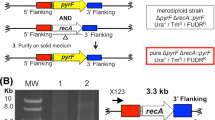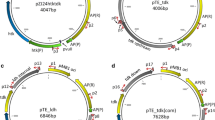Abstract
Along with the biochemical characterization of the enzymes involved in the process of cellulose degradation byClostridium thermocellum, a genetic approach based on the cloning of the genes has been developed. From a gene bank of C.thermocellum DNA in cosmid pHC79 (1), twoE. coli clones were isolated that produced endoglucanase activity, as demonstrated by the ability of crude extracts to release reducing sugars from soluble carboxymethylcellulose (CMC) while strongly reducing the viscosity.
The first clone, whose endoglucanase gene is termedcelA, produced an enzyme sharing immunological and catalytic properties with the Mr 56,000 endoglucanase (designated endoglucanase A) purified fromC. thermocellum culture supernatant by Pètre et al. (2). The second clone, carrying a gene termedcelB, produced a different enzyme, which failed to cross-react immunologically with anti-endoglucanase A antiserum and had a lower activity toward trinitrophenylated CMC (1).
Both genes were subcloned in vector pBR322 to yield plasmids that carryC. thermocellum DNA insertions of about 2.7 kb. The cloned sequences were used as probes to analyze restriction fragments of totalC. thermocellum DNA by Southern hybridization. Such studies demonstrated that the two genes share no homology and that they are not contiguous on theC. thermocellum chromosome.
For both genes, the level of endoglucanase activity was independent of their orientation, indicating thatE. coli transcription and translation systems recognize sequences of C.thermocellum DNA and RNA that are required for proper gene expression. From the specific activity of the purified enzymes, it was calculated that each represent 0.2–0.4% of totalE. coli protein, corresponding to at least 20–40% of their expression level inC. thermocellum.
Labeling of minicells containing the appropriate plasmids, followed by SDS-PAGE, demonstrated the synthesis of three immunologically related polypeptides encoded by thecelA gene, with Mr 56,000, 55,000, and 50,200, and one polypeptide of Mr 66,000 encoded by thecelB gene. In normalE. coli cells, the latter undergoes partial proteolysis and yields two active fragments of Mr 55,000 and 53,000. These fragments were purified and a specific antiserum was prepared. Ouchterlony double immunodiffusion tests and Western blot analysis showed that C.thermocellum culture supernatant contains a polypeptide of Mr 66,000 cross-reacting with antiserum made againstcelB protein synthesized inE. coli.
Similar content being viewed by others
References
Cornet, P., Tronik, D., Millet, J., and Aubert, J.-P. (1983),FEMS Microbiol. Lett. 16, 137.
Pètre, J., Longin, R., and Millet, J. (1981),Biochimie 63, 629.
Author information
Authors and Affiliations
Rights and permissions
About this article
Cite this article
Cornet, P., Millet, J., Beguin, P. et al. Cloning and expression of twoClostridium thermocellum endoglucanase genes inEscherichia coli . Appl Biochem Biotechnol 9, 349–350 (1984). https://doi.org/10.1007/BF02798970
Issue Date:
DOI: https://doi.org/10.1007/BF02798970




